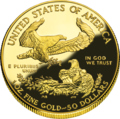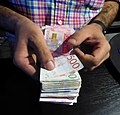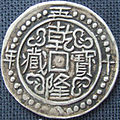Money payment for goods and services and repayment of debts , such as taxes , in a particular country or socio-economic context. The primary functions which distinguish money are: medium of exchange , a unit of account , a store of value and sometimes, a standard of deferred payment .
Money was historically an emergent market phenomenon that possessed intrinsic value as a commodity ; nearly all contemporary money systems are based on unbacked fiat money without use value . Its value is consequently derived by social convention, having been declared by a government or regulatory entity to be legal tender ; that is, it must be accepted as a form of payment within the boundaries of the country, for "all debts, public and private", in the case of the United States dollar .
The money supply of a country comprises all currency in circulation (banknotes and coins currently issued) and, depending on the particular definition used, one or more types of bank money (the balances held in checking accounts , savings accounts , and other types of bank accounts ). Bank money, whose value exists on the books of financial institutions and can be converted into physical notes or used for cashless payment , forms by far the largest part of broad money in developed countries. (Full article...
Bi-metallic coins are made up of a core with an outer ring. (e.g.: 500 yen coin ) Bi-metallic coins coins consisting of two (bi- metals or alloys , generally arranged with an outer ring around a contrasting center. Common circulating examples include the €1 , €2 , United Kingdom £1 and £2 , Canadian $2 , South Africa R5 , Egyptian £1 , Turkish 1 lira and 50 kurus , Indian ₹10 and ₹20 , Indonesian Rp1,000 , Polish 2 and 5 zł , Czech 50 Kč , Hungarian 100 and 200 Ft , Bulgarian 1 and 2 lv. , Hong Kong $10 , Argentine $1 and $2 , Brazilian R$1 , Chilean $100 and $500 , Colombian $500 and $1000 , Peruvian S/2 and S/5 , Albanian 100 Lekë , Thai 10 baht and all Mexican coins of $1 or higher denomination. For a more complete list, see List of bi-metallic coins . (Full article...
For editor resources and to collaborate with other editors on improving Wikipedia's Money-related articles, see WikiProject Numismatics
Do you have a question about Money-related content on Wikipedia that you can't find the answer to?
Consider asking it at the Wikipedia reference desk .
The following are images from various currency-related articles on Wikipedia.
Image 1 A 1914 British
gold sovereign (from
Money )
Image 3 Undated Kelzang tangka (1910), obverse (from
Tibetan tangka )
Image 4 Tibetan "gaden" Tangka, undated (ca. AD 1840), reverse (from
Tibetan tangka )
Image 5 US dollar banknotes (from
Money )
Image 6 President
J. K. Paasikivi illustrated in a former Finnish
10 mark banknote from 1980 (from
Money )
Image 7 Tibetan undated silver tangka, struck in 1953/54, obverse. (from
Tibetan tangka )
Image 8 Tibetan "gaden" Tangka, undated (ca. AD 1840), obverse (from
Tibetan tangka )
Image 9 Punch-marked coins discovered from
Chandraketugarh . (from
Punch-marked coins )
Image 10 Gold coins are an example of legal tender that are traded for their intrinsic value, rather than their face value. (from
Money )
Image 11 Undated Kelzang tangka (1910), reverse (from
Tibetan tangka )
Image 12 Tibetan undated silver tangka (2nd half of 18th century) with eight times the syllable "dza" in vartula script, reverse (from
Tibetan tangka )
Image 13 "Bent bar" of the Gandhara Janapda unearthed with Achaemenid and Greek coins,
Gandhara , c.350 BC. (from
Punch-marked coins )
Image 14 Banknotes of different currencies with a face value of 5000 (from
Money )
Image 15 Song Dynasty
Jiaozi , the world's earliest paper money (from
Money )
Image 16 Paper money from different countries (from
Money )
Image 17 Tibetan silver tangka with Ranjana (Lantsa) script, dated 15-28 (= AD 1894), obverse (from
Tibetan tangka )
Image 18 Sino Tibetan silver tangka, dated 58th year of Qian Long era, reverse. Weight 5.57 g. Diameter: 30 mm (from
Tibetan tangka )
Image 19 Ancient Jewish coin , engraved
menorah , from the
Hasmoneon kingdom 37-40 BCE (from
Money )
Image 20 A 640 BC one-third
stater electrum coin from
Lydia . According to
Herodotus , the
Lydians were the first people to introduce the use of
gold and
silver coins . It is thought by modern scholars that these first stamped
coins were minted around 650 to 600 BC. (from
Money )
Image 21 Printing paper money at a printing press in
Perm (from
Money )
Image 22 Tibetan undated silver tangka, struck in 1953/54, reverse. (from
Tibetan tangka )
Image 23 A person counts a bundle of different
Swedish banknotes. (from
Money )
Image 24 Money Base, M1 and M2 in the U.S. from 1981 to 2012 (from
Money )
Image 25 A hoard of mostly
Mauryan punch-marked coins (from
Punch-marked coins )
Image 26 Tibetan kong par tangka, dated 13-45 (= AD 1791), obverse (from
Tibetan tangka )
Image 27 Tibetan undated silver tangka (2nd half of 18th century) with eight times the syllable "dza" in vartula script, obverse (from
Tibetan tangka )
Image 28 A check, used as a means of converting funds in a
demand deposit to cash (from
Money )
Image 29 Sino Tibetan silver tangka, dated 58th year of Qian Long era, obverse. Weight 5.57 g. Diameter: 30 mm (from
Tibetan tangka )
Image 30 Silver, ½ Karshapana coin, “Babyal Hoard” type, of the Kuru Janapada (450 BC - 315 BC) (from
Punch-marked coins )
Image 31 Tibetan kong par tangka, dated 13-45 (= AD 1791), reverse (from
Tibetan tangka )
Image 32 Tenga of
Muhammad Khudayar Khan , struck at the Kokand mint, dated 1862–1863 (from
Kokand tenga )
Image 33 Huizi currency , issued in 1160 (from
Money )
Image 34 “Babyal Hoard” type, of the Kuru Janapada (350 - 315 BCE) (from
Punch-marked coins )
Image 35 Tibetan silver tangka with Ranjana (Lantsa) script, dated 15-28 (= AD 1894), reverse (from
Tibetan tangka )
Select [►] to view subcategories
Category puzzle
– By region –
North Central East South West
North Caribbean Central South
Currencies of Asia
Central East North South Southeast West
European Union Eastern Southern Western
General Administration Fiscal provisions Economy International status Denominations
Coins by country with minting rights
Potential adoption by
History
General Previous EU members
Preceding currencies Former fiscal provisions
– By name –
Circulating Obsolete Proposed As a denomination
Circulating Obsolete As subunit See also
Circulating Circulating, but renamed Obsolete and historical Noncirculating Conceptual Virtual Fictional Private See also
Circulating Obsolete Private See also
Circulating Obsolete As a denomination See also
Circulating Obsolete As a denomination
Circulating Local alternative currency Obsolete and historical Historical antecedents (mass) See also
Circulating Historical rubles Ruble reforms Banknotes (by value in rubles) Coins (value in rubles) Monetary surrogates Production facilities Designers
Circulating Obsolete Conceptual Fictional See also
Circulating Obsolete As subunit See also
19th century 18th century 17th century 15th and 16th centuries See also
– By country –
Canadian currency
Topics Circulating currency
Historical coinage
Banknote series Historical currencies Commemoratives Bullion Pre-confederation Community currencies Other
Current coins Withdrawn coins Banknote series See also
Hong Kong currency
Topics Coinage Banknotes Banknote issuers
Topics CirculatingJapanese yen )
Historical
Historical
Commemoratives
Currency and coinage of the Netherlands
Institutions Banknotes Pre-decimal guilder coins Decimal guilder coins Euro coins See also
New Zealand currency
Currency Coins Banknotes Obsolete denominations
Related topics
Current
Obsolete
Topics Ancient currencies Banknote and coin series
Current Obsolete * Unrecognized
Topics Coins
Currency
Discontinued denominations Discontinued currency types
Related
Topics Coins Banknotes Former currencies Withdrawn coins Withdrawn banknotes
– Historical currencies –
Historical currencies of
Korea
Mun 998–1105, Yang 1892–1902 Won 1902–1910 Yen 1902–1945
Topics Coinage Banknotes Former banknotes
10 bani 25 bani 50 bani 2 lei 3 lei 25 lei 1,000 lei 2,000 lei 5,000 lei 10,000 lei 50,000 lei 100,000 lei 500,000 lei 1,000,000 lei 5,000,000 lei Former coinage
– Other –
Purge server cache






























































